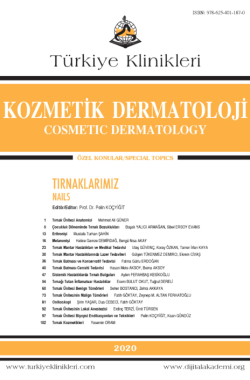Melanonychia
Hatice Gamze DEMİRDAĞa, Bengü Nisa AKAYb
aSerbest Hekim, Ankara, TÜRKİYE
bAnkara Üniversitesi Tıp Fakültesi, Deri ve Zührevi Hastalıkları ABD, Ankara, TÜRKİYE
Demirdağ HG, Akay BN. Melanonişi. Koçyiğit P, editör. Tırnaklarımız. 1. Baskı. Ankara: Türkiye Klinikleri; 2020. p.16-22.
ABSTRACT
Melanonychia refers to a black-brown-grey pigmentation of the nail plate. It is caused by the presence of melanin and commonly appears as a longitudinal band (longitudinal melanonychia). Differential diagnosis encompasses benign and malignant conditions. Nail dermatoscopy (onychoscopy) is a reliable diagnostic tool that provides useful information about nail pigmentations. In this article, the causes, clinical and dermatoscopic features of melanonychia have been reviewed through an algorithm.
Keywords: Melanonychia; dermatoscopy; onychoscopy; nail diseases; melanoma
Kaynak Göster
Referanslar
- Tosti A, Piraccini BM, de Farias Dc. Dealing with melanonychia. Semin cutan Med Surg. 2009;28(1):49-54. [Crossref] [PubMed]
- Starace M, Alessandrini A, Brandi N, Piraccini BM. Use of Nail Dermoscopy in the Management of Melanonychia: Review. Dermatol Pract concept. 2019;9(1):38-43. [Crossref] [PubMed] [PMC]
- Piraccini BM, Alessandrini A, Starace M. onychoscopy: Dermoscopy of the Nails. Dermatol clin. 2018;36(4):431-8. [Crossref] [PubMed]
- Braun RP, Baran R, le Gal FA, Dalle S, Ronger S, Pandolfi R, et al. Diagnosis and management of nail pigmentations. J Am Acad Dermatol. 2007;56(5):835-47. [Crossref] [PubMed]
- Thomas l, Dalle S. Dermoscopy provides useful information for the management of melanonychia striata. Dermatol Ther. 2007;20(1):3-10. [Crossref] [PubMed]
- Piraccini BM, Dika E, Fanti PA. Tips for diagnosis and treatment of nail pigmentation with practical algorithm. Dermatol clin. 2015;33(2):185-95. [Crossref] [PubMed]
- Haenssle HA, Blum A, Hofmann-Wellenhof R, Kreusch J, Stolz W, Argenziano G, et al. When all you have is a dermatoscope- start looking at the nails. Dermatol Pract concept. 2014;4(4):11-20. [Crossref] [PubMed] [PMC]
- Akay BN. Tırnak Hastalıkları. özdemir F, editör. Dermoskopi Atlası. 1. Baskı. Ankara: Dünya Tıp Kitabevi. 2017. p317-50.
- Di chiacchio N, Ruben BS, loureiro WR. longitudinal melanonychias. clin Dermatol. 2013;31(5):594-601. [Crossref] [PubMed]
- Di chiacchio ND, Farias Dc, Piraccini BM, Hirata SH, Richert B, Zaiac M, et al. consensus on melanonychia nail plate dermoscopy. An Bras Dermatol. 2013;88(2):309-13. [Crossref] [PubMed] [PMC]
- Kilinc Karaarslan ı, Acar A, Aytimur D, Akalin T, ozdemir F. Dermoscopic features in fungal melanonychia. clin Exp Dermatol. 2015;40(3):271-8. [Crossref] [PubMed]
- Ronger S, Touzet S, ligeron c, Balme B, viallard AM, Barrut D, et al. Dermoscopic examination of nail pigmentation. Arch Dermatol. 2002;138(10):1327-33. [Crossref] [PubMed]
- Phan A, Dalle S, Touzet S, Ronger-Savlé S, Balme B, Thomas l. Dermoscopic features of acral lentiginous melanoma in a large series of 110 cases in a white population. Br J Dermatol. 2010;162(4):765-71. [Crossref] [PubMed]
- Singal A, Arora R. Nail as a window of systemic diseases. ındian Dermatol online J. 2015;6(2):67-74. [Crossref] [PubMed] [PMC]
- lencastre A, lamas A, Sá D, Tosti A. onychoscopy. clin Dermatol. 2013;31(5):587-93. [Crossref] [PubMed]
- Koga H. Dermoscopic evaluation of melanonychia. J Dermatol. 2017;44(5):515-7. [Crossref] [PubMed]
- Koga H, Saida T, Uhara H. Key point in dermoscopic differentiation between early nail apparatus melanoma and benign longitudinal melanonychia. J Dermatol. 2011;38(1):45-52. [Crossref] [PubMed]
- cooper c, Arva Nc, lee c, Yélamos o, obregon R, Sholl lM, et al. A clinical, histopathologic, and outcome study of melanonychia striata in childhood. J Am Acad Dermatol. 2015;72(5):773-9. [Crossref] [PubMed]
- Koga H, Yoshikawa S, Shinohara T, le Gal FA, cortés B, Saida T, et al. long-term Followup of longitudinal Melanonychia in children and Adolescents Using an objective Discrimination ındex. Acta Derm venereol. 2016;96(5):716-7. [Crossref] [PubMed]
- Benati E, Ribero S, longo c, Piana S, Puig S, carrera c, et al. clinical and dermoscopic clues to differentiate pigmented nail bands: an ınternational Dermoscopy Society study. J Eur Acad Dermatol venereol. 2017;31(4):732-6. [Crossref] [PubMed]
- Ko D, oromendia c, Scher R, lipner SR. Retrospective single-center study evaluating clinical and dermoscopic features of longitudinal melanonychia, ABcDEF criteria, and risk of malignancy. J Am Acad Dermatol. 2019;80(5):1272-83. [Crossref] [PubMed]
- Baran R, Kechijian P. Hutchinson's sign: a reappraisal. J Am Acad Dermatol. 1996;34(1):87-90. [Crossref] [PubMed]
- Grover c, Jakhar D. Diagnostic utility of onychoscopy: review of literature. ındian J Dermatopathol Diagn Dermatol. 2017;4(2):31-40. [Crossref]
- Hirata SH, Yamada S, Enokihara MY, Di chiacchio N, de Almeida FA, Enokihara MSSM, et al. Patterns of nail matrix and bed of longitudinal melanonychia by intraoperative dermatoscopy. J Am Acad Dermatol. 2011;65(2):297-303. [Crossref] [PubMed]
- Göktay F, Güneş P, Yaşar ş, Güder H, Aytekin S. New observations of intraoperative dermoscopic features of the nail matrix and bed in longitudinal melanonychia. ınt J Dermatol. 2015;54(10):1157-62. [Crossref] [PubMed]

